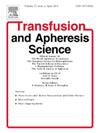Comparison of anti-A and anti-B isoagglutinin titers by conventional tube and column agglutination technique in O Rh-D positive mothers and their impact on neonatal outcomes
IF 1.2
4区 医学
Q4 HEMATOLOGY
引用次数: 0
Abstract
Background
Maternal IgG anti-A and anti-B isoagglutinin titers are key predictors of neonatal outcomes in ABO incompatibility-related hemolytic disease of the fetus and new-born (HDFN). This study aimed to compare the Column Agglutination Technique (CAT) and conventional tube technique (CTT) in measuring maternal IgG anti-A and anti-B isoagglutinin titers and assess their correlation with neonatal outcomes.
Material and methods
This prospective observational study included 125 O Rh-D positive pregnant mothers and their neonates with A, or B blood groups. Maternal antibody titers were measured using both CTT and CAT. Neonates were monitored for jaundice, serum bilirubin levels, direct antiglobulin test (DAT) results, and treatment needs. Statistical analyses compared the two methods and correlated maternal titers with neonatal outcomes.
Results
Maternal anti-A titers by CTT ranged from 1 to 64, and anti-B titers from 1 to 32. By CAT, anti-A and anti-B titers ranged from 4 to 256. Median titers were significantly higher by CAT (p < 0.05). A strong positive correlation was observed between maternal titers and neonatal serum bilirubin (r = 0.45, p < 0.05). Neonates with positive DAT had higher maternal titers (p = 0.038 for CTT; p = 0.027 for CAT). Neonates with higher maternal titers required double volume exchange transfusion (DVET), while those with lower titers needed phototherapy (p = 0.007).
Conclusion
The CAT method is more sensitive for measuring anti- A and B isoagglutinin titers than CTT. Both methods showed strong correlation and can guide ABO-HDFN management based on available resources.
Rh-D阳性母亲常规试管和柱凝集法抗a和抗b异凝集素滴度的比较及其对新生儿结局的影响
背景:母体IgG抗a和抗b异凝集素滴度是ABO不相容相关的胎儿和新生儿溶血性疾病(hddn)新生儿结局的关键预测因子。本研究旨在比较柱凝集技术(CAT)和常规试管技术(CTT)检测母体IgG抗a和抗b异凝集素滴度,并评估其与新生儿结局的相关性。材料和方法本前瞻性观察研究纳入了125名O Rh-D阳性的孕妇及其A或B血型的新生儿。采用CTT和CAT检测母源抗体滴度。监测新生儿黄疸、血清胆红素水平、直接抗球蛋白试验(DAT)结果和治疗需求。统计分析比较了两种方法,并将母体滴度与新生儿结局联系起来。结果母体CTT抗a滴度为1 ~ 64,抗b滴度为1 ~ 32。CAT检测,抗a、抗b滴度在4 ~ 256之间。CAT检测中位滴度显著升高(p <; 0.05)。母体滴度与新生儿血清胆红素呈正相关(r = 0.45,p <; 0.05)。DAT阳性的新生儿CTT母体滴度较高(p = 0.038;p = 0.027 (CAT)。母亲滴度较高的新生儿需要双容量交换输血(DVET),而滴度较低的新生儿需要光疗(p = 0.007)。结论CAT法测定抗A、B异凝集素滴度比CTT法灵敏。两种方法具有较强的相关性,可指导基于现有资源的abo - hdn管理。
本文章由计算机程序翻译,如有差异,请以英文原文为准。
求助全文
约1分钟内获得全文
求助全文
来源期刊
CiteScore
3.60
自引率
5.30%
发文量
181
审稿时长
42 days
期刊介绍:
Transfusion and Apheresis Science brings comprehensive and up-to-date information to physicians and health care professionals involved in the rapidly changing fields of transfusion medicine, hemostasis and apheresis. The journal presents original articles relating to scientific and clinical studies in the areas of immunohematology, transfusion practice, bleeding and thrombotic disorders and both therapeutic and donor apheresis including hematopoietic stem cells. Topics covered include the collection and processing of blood, compatibility testing and guidelines for the use of blood products, as well as screening for and transmission of blood-borne diseases. All areas of apheresis - therapeutic and collection - are also addressed. We would like to specifically encourage allied health professionals in this area to submit manuscripts that relate to improved patient and donor care, technical aspects and educational issues.
Transfusion and Apheresis Science features a "Theme" section which includes, in each issue, a group of papers designed to review a specific topic of current importance in transfusion and hemostasis for the discussion of topical issues specific to apheresis and focuses on the operators'' viewpoint. Another section is "What''s Happening" which provides informal reporting of activities in the field. In addition, brief case reports and Letters to the Editor, as well as reviews of meetings and events of general interest, and a listing of recent patents make the journal a complete source of information for practitioners of transfusion, hemostasis and apheresis science. Immediate dissemination of important information is ensured by the commitment of Transfusion and Apheresis Science to rapid publication of both symposia and submitted papers.

 求助内容:
求助内容: 应助结果提醒方式:
应助结果提醒方式:


